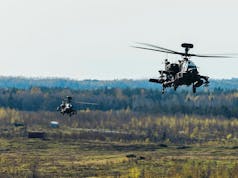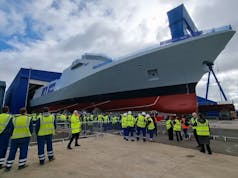QinetiQ has won a contract to develop its unique Software Defined Multifunction LIDAR technology to a flight ready payload.
LIDAR is like radar but uses light instead of radio waves, enabling airborne intelligence, surveillance and reconnaissance (ISR) optical collection capabilities and secure, high bandwidth optical comms between land, air, sea and space nodes.
The multi-million pound contract – which will be match-funded by the QinetiQ led team – has been awarded by the UK Defence Solutions Centre (DSC). The QinetiQ led team is the winner of the UK DSC innovation “Capability Proving” programme. The team consists of Glyndwr Innovations, Airbus and Thales to deliver the contract. The two-year programme is expected to be followed by airborne and shipborne trials.
Brian Perrett at QinetiQ said:
“QinetiQ’s SDML is the only multi-function LIDAR currently in development, and represents a truly transformational capability – not simply an incremental improvement of an existing technology. We’re thrilled that the UK DSC has recognised its game-changing capabilities and potential for application.
This is a great example of UK Government funding helping to bring UK innovation to market. It is also a clear demonstration of QinetiQ’s commitment to investing in the future, building on our leading position as a hub for novel high power and low power laser technology.”
Sophie Thomas, Head of the Zephyr Programme, Airbus adds:
“It’s an exciting time to be working in HAPS technology as we are seeing a step change in what this technology will bring. We are looking forward to applying our knowledge and experience gained during our many hours of successful flights with the Zephyr S, our leading solar-electric, stratospheric UAV, to develop this future HAPS payload.”
“It is exciting to partner with QinetiQ and Airbus on this payload project, and it’s a great opportunity to progress the work we did during the competition to deliver a system that can give HAPS platforms exciting new capability” says Richard Hazelwood Sales Manager for Glyndwr Innovations.
Airbus Defence and Space won an order from the UK for three solar-powered Zephyr 8 high-altitude pseudo-satellite aircraft some few years ago. In November 2015, then British prime minister David Cameron laid out plans during the 2015 Strategic Defence Review, to further enhance the UK’s intelligence, surveillance and reconnaissance capacity.
In the speech given to parliament at the time, he stated that the UK was to field a “British designed unmanned aircraft that will fly at the edge of the earth’s atmosphere and allow us to monitor our adversaries for weeks on end, providing critical intelligence for our armed forces.”
Zephyr-8 is the latest version of a highly sophisticated series of ultra-lightweight UAVs, capable of flying up to 70,000ft – twice the altitude of a commercial airliner – for up to 45 days at a time. Referred to as a High Altitude Pseudo Satellite, it performs more like a satellite than a conventional UAV. The system is capable of providing persistent surveillance over land or sea, and hosting communications links, over the same area for months at a time without landing. The precise purposes for which the UK MoD will use its Zephyrs have not been disclosed.
The aircraft flies slowly, loitering over a selected area under the close guidance of a ground controller to perform its mission.
According to Airbus, the latest generation Zephyr 8 has “a wingspan of 25 metres, is 30% lighter and can carry 50% more batteries than its predecessor”. This Airbus say, enables the aircraft to carry heavier payloads for its surveillance and communications roles. The Zephyr 8 is designed to fly continuously for over a month before landing, being refurbished, and flying again.
As well as military purposes, Zephyrs can be used for humanitarian missions, precision farming, environmental and security monitoring, and to provide internet coverage to regions of poor or zero connectivity.
The first aircraft is under construction at Airbus Defence and Space’s Farnborough, UK facility and is due to fly in mid-2017.













Is this a rehash of an old story. Seems to be. Last paragraph gives it away. First aircraft should fly in mid 2017. In the past then.
Both RADAR and LIDAR use electromagnetic waves with very similar properties – the main difference being LIDAR uses much higher frequency ones (either visible light or near-visible parts of the spectrum via a LASER). Both have advantages and disadvantages, so I presume the aircraft will use both to maximise its potential?
Not on Zephyr S. The weight and power limitations realistically mean that only one surveillance outfit can be carried. Radar is under deveopment for Zephyr as well. In conjunction with E/O turrets its a great capability.
Zephyr T, the next step forward, could potentially carry more packages, particularly as they get smaller. This is very new and the MoD should be commended for moving fast. They’re currently testing in Australia. It’s likely the US will buy or lease some from Airbus for testing.
Given the speed at which solar, battery, sensor and motor tech (and size) is moving forward the next 5-10 years will be key. It wouldn’t be impossible for the generation beyond Zephyr T (which to be fair has yet to be built) could carry a complete sensor outfit including E/O, Synthetic Aperture Radar, LIDAR, Radio Relay and ESM. If you could get all of those onboard and network them together, in addition to the goal of 90 days flight duration and ability to operate in higher latitudes and keep the cost low (think £2m per copy) you have an incredible capability. You could quite literally send an RN Destroyer or Frigate (or Aircraft Carrier) to sea with a number of Zephyr’s going along with it for the entire deployment. The savings on helicopter fuel and airframe hours would pay for it alone.
Stick 10 or 12 of them around a Carrier and you have a cheap, persistent sensor network that could replace AEW…no need to satelltite comms either as at 70,000ft they have a line of sight of over 250 miles.
Would this ultimately complement or replace any other platforms?